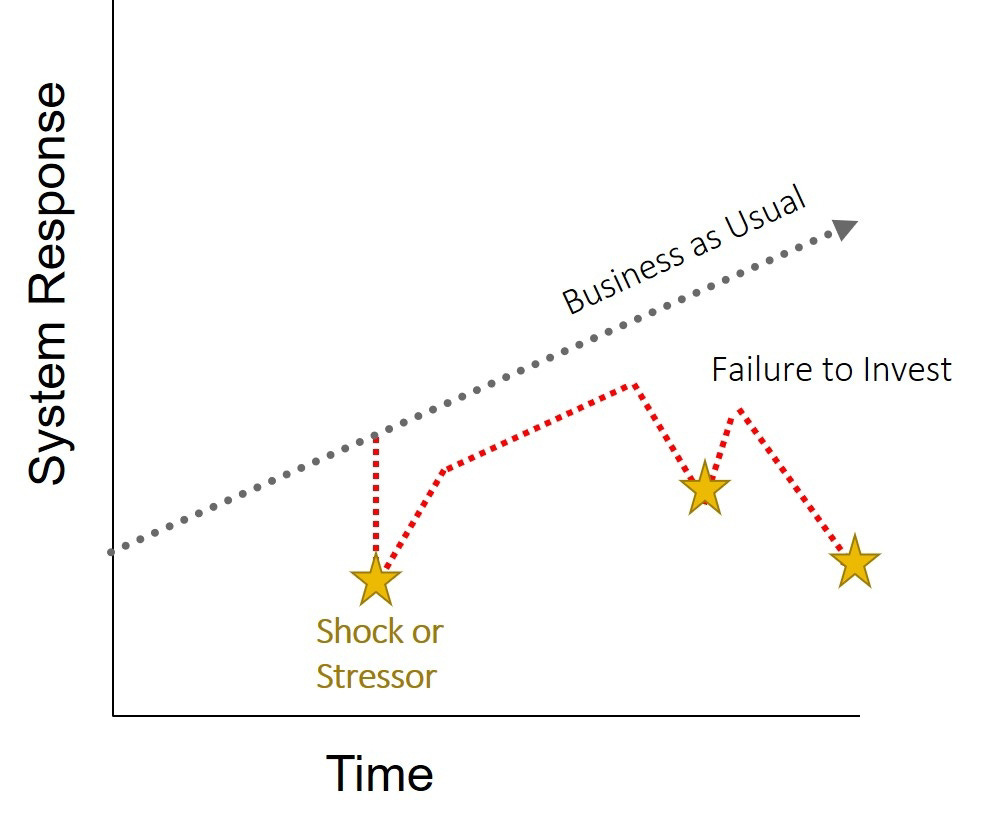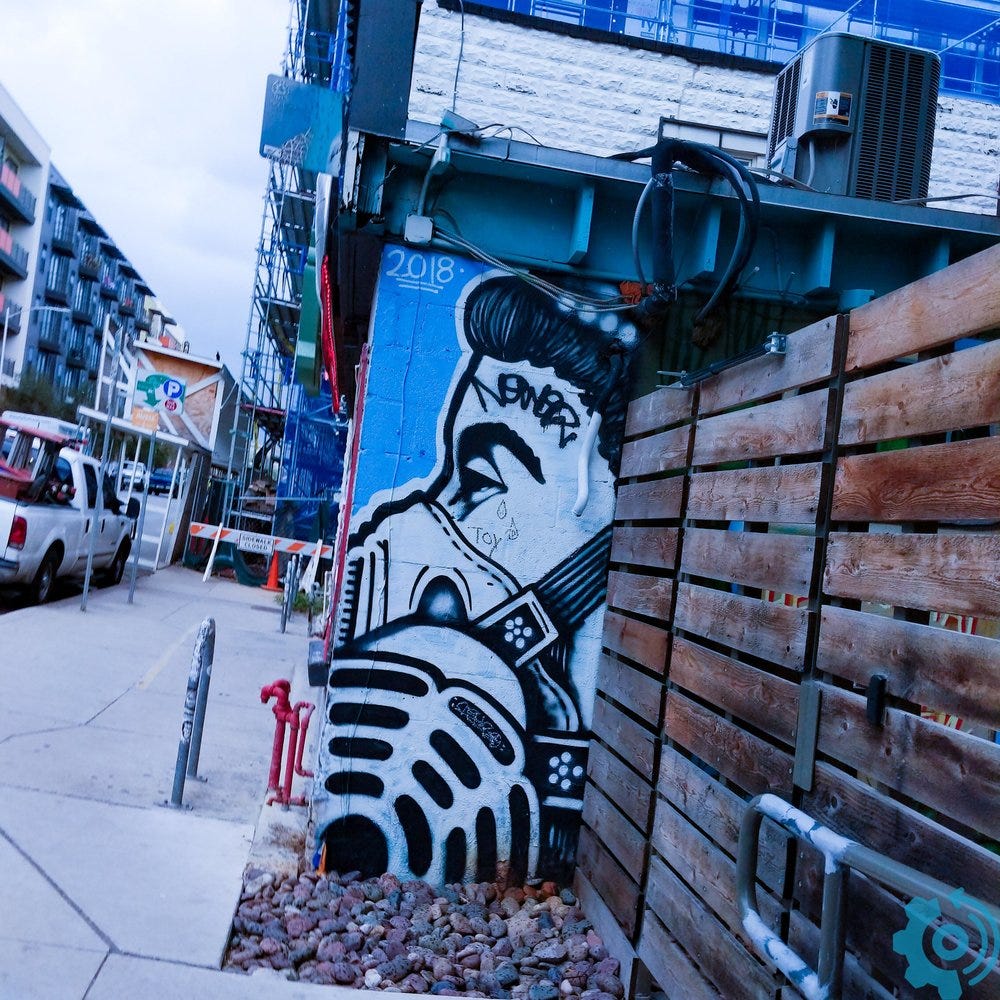Resiliency - a comparative guide to design and personal trauma
Us humans have been getting our butts kicked between droughts, hurricanes, and wildfires. We see this cyclical pattern. Disaster occurs, people band together in support, finger pointing starts, recovery happens, life moves on.
In disaster, compassion fatigue is a type of densensitization to seeing the tragedy again and again. It's not normally a term used for bystanders but I'd argue that none of us are bystanders to the changing world around us.
What's the antidote?
Resiliency.

But as an engineer, that's not my definition of the word. Being able to rebuild from hardship is recovery. Resiliency is a repellent to hardship. It’s the bounce-back factor. You continue to survive, adapt, and grow no matter what sorts of shocks and stressors you experience. Resiliency is a state that when you experience those hardships again, your limbic system moves right past it, not even a blip on the radar.
Acute shocks and obtuse stressors
You can relate if you've ever been through personal trauma, the capital letter Personal Trauma or the lower case. You move along your timeline where trauma is either a reoccurring experience or a strike to the status quo. A shock is trauma on an instantaneous timescale: a untimed breakup, a sudden death, an accident. A chronic stress is d/dt. It has a longer duration like relationship struggles, a medical condition, or an unmanageable semester. I don't need to elaborate in a nation where 77% of people regularly experience symptoms of stress and 48% say stress negatively impacts their daily lives. Trauma is the next step where there is deep emotional residue.
Infrastructure experiences hazards and disaster in the same fashion.

This is the graphical representation of the concept. We have our system which we've used past conditions, past experience, and past knowledge to design. This is what is referred to as a closed system in systems theory. Everything that occurs in the system is influenced by drivers within the system's boundaries. In the context of engineering, and without giving any credit to the nuance, we have an arbitrary design life of 50 years and we maintain and make upgrades as new technologies come out. It's business as usual.
Disaster is uncertainty
Think of hurricanes, wildfires, and floods as acute shocks. Hazards like sea-level rise and changing temperatures are stressors which impact our infrastructure and alter how they've been designed to operate. In our social systems, these tend to not get the news attention as a shock would. But it's important to realize that stressors are wearing down our systems day by day.

In infrastructure, hazards don't have to be natural or weather-related. There are human-made shocks (cyber attacks) and stressors (endemic violence).
Recovering from disaster with resiliency
Before we get back into personal trauma, I want to walk through how engineers respond to emergencies. Following hazard impact, we are now faced with 2 options:
Replace-in-kind
Build-back-better
Both options are discussed widely in our industry. The first is a pretty typical upgrade design. Replace or add redundancy with similar equipment. The second is an investment in future performance if it makes sense from a balance of feasibility, cost, and effectiveness. Cost can be tangible or intangible.

Resiliency is smoothing out the peaks of disaster. The next shock or stress is below the ordinary high water mark. It has minimal impact. It is not the controlling parameter on when you upgrade or replace, meaning that you can capital plan for changes to your system instead of reacting (many times at a cost 3 times as much).
Not using disaster as a path of opportunity to build back better is failing to invest in the performance and failing to safeguard against now-known certain hardships. It has the potential to cascade into disrepair, like during this event in 2017, where some equipment was down for maintenance and some was completely out of service leaving a vulnerable system.
The third option
There's also a third option. I didn't mention it above because in most cases, it's not one that's a part of recovery. It's the option of stagnant non-recovery or cascading decline.
In an example from my personal life, the third option was do nothing. It would be carrying hurt and loneliness with me forever. Or throwing in the towel.
In engineering, this is total system failure without an option to upgrade or rebuild. It's apocalypse. It's being so short in money and community and vision that there is no future. It's crumbling infrastructure without the support to build in kind or upgrade to something different.
The third option then looks less of an option and is more of another chronic stressor. Failure to recover (either intentional or unintentional) is another hazard that the system will need to recover from.
Resiliency is preparing for future conditions
So what were my 2 actual options?
Get through it. Box in the emotions and lock it up in a deep vault. Make it through without defaulting on the third option.
Embrace the hurt and learn from it.
You may remember from my post on it, that I chose to embrace my community. I deepened my empathy and connection with others. In truth, I tear up thinking of some of the stories I heard from you
.The amazing thing about the elasticity of humans is that option 2 can be more than just using the past to understand why it might happen again. It's more than just knowing it might happen again and knowing coping mechanisms for it. Option 2 can be resiliency. That is, understanding our own personal boundaries and being intentional about who we allow to occupy our spaces. It's working on ourselves and understanding ourselves better so that it's worth it having been through that shock or stress. It's seeing things through new eyes, free of its typical judgmental baggage.
This is an acknowledgement of the dynamic quality of our self systems. There are drivers that effect performance that are external to our system's boundaries. There are potential hazards and disasters that are outside our control but we can better manage stress, gain emotional intelligence and develop a support network so that we can confront greater catastrophes in the future.
According to Darwin’s Origin of Species, it is not the most intellectual of the species that survives; it is not the strongest that survives; but the species that survives is the one that is able best to adapt and adjust to the changing environment in which it finds itself. -Leon C. Megginson, 1963
The past is not a good indicator of the future
The same is true in engineering. With a bit of planning and modeling, we can safeguard a bit better. We know that for each 1°C that climate increases, we'll see about 6-7% increase in intensity for extreme precipitation.
Instead of using past conditions and assuming closed systems, we can look to future scenarios to extrapolate future equipment needs. If we don't do this, our equipment may not survive long enough to reach its intended design life. We need to be using our best guess at conditions which will occur at the end of that equipment's design life. To fail to do this is a design flaw.
With climate change approaching more quickly than ever, it is critical that we use our risk and resiliency experience to create a strong framework to evaluate, plan, adapt and mitigate to the growing threat so that we can sustain our infrastructure and communities today and into the future. - Jason Bird
Every single project needs to have a resiliency component.
Implementing new design standards
We live in a complex open system, with interconnected factors and potential for cascading failures. We lived that during Hurricane Harvey when the shut down of the power system left water treatment plants, hospitals, and refineries without power, splintering into other regional economies.
Stressors also effect our designs. In the case of a wastewater plant, it's knowing that with elevated groundwater levels, there will be elevated infiltration & inflow into the wastewater pipes. That will lead to larger amounts to be treated leading to a larger sizing of our plants. Maybe it requires new guidelines for the sizing of freeboards or entirely new basins for wet weather flows. In short, we need to focus on whole-systems thinking instead of designing by isolation.

Stressors also effect our designs. In the case of a wastewater plant, it's knowing that with elevated groundwater levels, there will be elevated infiltration & inflow into the wastewater pipes. That will lead to larger amounts to be treated leading to a larger sizing of our plants. Maybe it requires new guidelines for the sizing of freeboards or entirely new basins for wet weather flows. In short, we need to focus on whole-systems thinking instead of designing by isolation.
Resiliency efforts
After some googling around, I found it difficult to locate credible climate prediction models for specific areas. There's no "rule of thumb" or dashboard to pull location-specific climate projections. If I'm working on a design in my hometown, there's no single source of information about potential hazards 50 years out. Not unless the city has completed a resiliency planning program. California created its own working group to begin the conversation between engineering, architects, and scientists. NYC has its own climate resiliency design guidelines from their resiliency program. Some municipalities can find funding for this crucial infrastructure-climate collaboration. Others have no appetite for talking about politically charged issues, regardless of the co-benefits of upgrading and hardening their systems (such as reduced life cycle costs with more efficient power systems).
Our climate is changing with or without government-backed climate initiatives for infrastructure. Humans need to be agile enough to react. Our infrastructure needs to be just as agile.
Reading: The Big Necessity by Rose George. It talks about the underbelly of society -- the toilet. It's interesting to see how a reporter talks about wastewater and its processes. The big takeaway that I got.... is that I need to invest in a Toto toilet with automatic closing lid and bidet. Treat yoself... for the environment.
Listening: Esther Perel's the State of Affairs. She talks about relationships and how they've evolved throughout time through the lens of infidelity (as the title suggests). I love her podcast Where Should We Begin?.
Working: I just completed a workshop where we talked risk and cost profile for the upgrade of a dam. We needed to align ourselves with the client's vision of cost, schedule, and design life. Resiliency in action!






